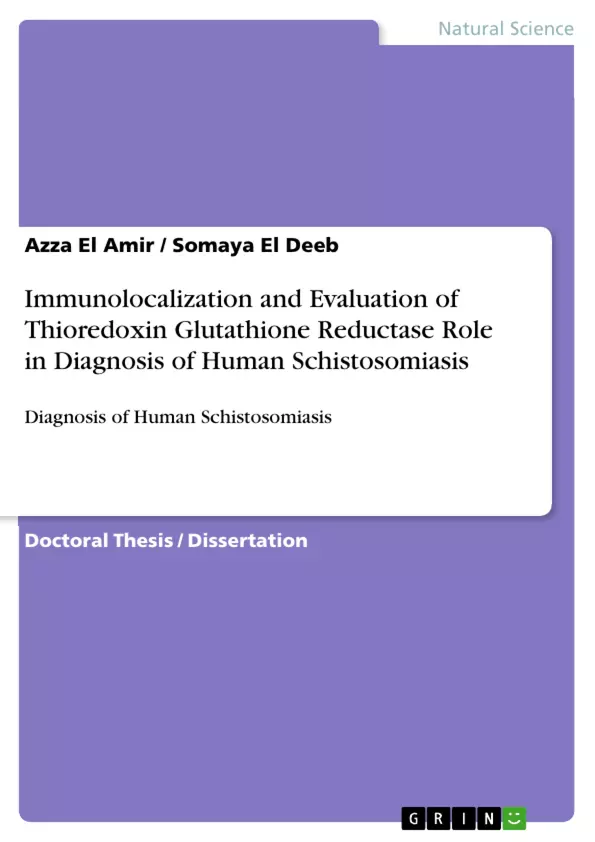Schistosoma parasite continued to be focus of the solicitude investigators to control the prevalence of the parasite. The efforts are needed for sensitive and accurate diagnosis that can utilize to rapidly map the prevalence of the disease. Our study aimed to benefit from the necessity of the S. mansoni for enzyme TGR, in utilization of the enzyme as an antigen target and evaluate its efficacy in the diagnosis of S. mansoni infection patients. The results revealed that smTGR could be detected in various organs of infected mice and localized in all parasites life cycle stages except eggs using smTGR pAb. Sandwich ELISA reveled that this antigen can be relied as a diagnostic antigen target in serum and urine.
Inhaltsverzeichnis (Table of Contents)
- ABBREVIATIONS
- INTRODUCTION
- MATERIALS AND METHODS
- RESULTS
- DISCUSSION
- CONCLUSION
- REFERENCES
Zielsetzung und Themenschwerpunkte (Objectives and Key Themes)
This study aimed to investigate the potential of thioredoxin glutathione reductase (TGR) as a diagnostic target for human schistosomiasis. The research focused on the localization of TGR in different organs of infected mice and its presence in various life cycle stages of the parasite. The study also evaluated the efficacy of TGR as a diagnostic antigen in serum and urine samples using sandwich ELISA.
- Localization of TGR in infected mice
- TGR expression in different life cycle stages of Schistosoma mansoni
- Evaluation of TGR as a diagnostic antigen for schistosomiasis
- Development of a sandwich ELISA for TGR detection
- Potential of TGR as a target for drug development
Zusammenfassung der Kapitel (Chapter Summaries)
The introduction provides background information on schistosomiasis, highlighting the importance of accurate and sensitive diagnostic tools. It also introduces the role of TGR in the parasite's survival and its potential as a diagnostic target. The materials and methods section describes the experimental procedures, including the preparation of antigens, the development of antibodies, and the execution of immunolocalization and ELISA assays. The results section presents the findings of the study, including the localization of TGR in different organs and life cycle stages, as well as the diagnostic efficacy of TGR in serum and urine samples. The discussion analyzes the results and their implications for schistosomiasis diagnosis and control. The conclusion summarizes the key findings and suggests future research directions.
Schlüsselwörter (Keywords)
Schistosomiasis, diagnosis, thioredoxin glutathione reductase (TGR), immunolocalization, sandwich ELISA, polyclonal antibody, Schistosoma mansoni, antigen target, diagnostic efficacy.
- Citar trabajo
- Azza El Amir (Autor), Somaya El Deeb (Autor), 2003, Immunolocalization and Evaluation of Thioredoxin Glutathione Reductase Role in Diagnosis of Human Schistosomiasis, Múnich, GRIN Verlag, https://www.grin.com/document/279764



